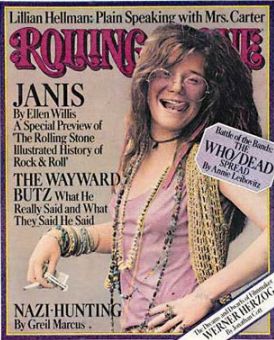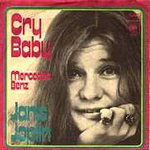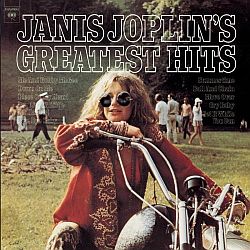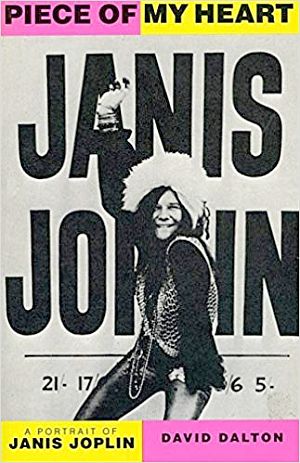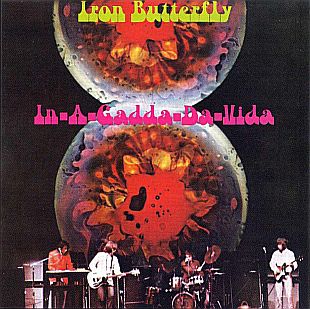
Cover of Iron Butterfly’s June 1968 Atco album which includes the famous 17-minute ''In-A-Gadda-Da-Vida'' track.
In any case, Iron Butterfly was a group that made the music of its day. Four California musicians established the group in 1966. Vocalist, organist, and bandleader, Doug Ingle, formed the first version of the group in San Diego with drummer Ron Bushy and two others.
The Iron Butterfly sound was long and heavy. The group’s style was similar to that of acts such as Blue Cheer and Steppenwolf. Iron Butterfly’s music helped provide a bridge of sorts from the “psychedelia sound” to the heavy metal music that followed, influencing groups from Deep Purple to Led Zeppelin. “Now remembered as a passing fancy of the acid-rock era,” observes one writer describing the group in the Rolling Stone Encyclopedia of Rock and Roll, “at its peak Iron Butterfly was considered a leading hard rock band.”
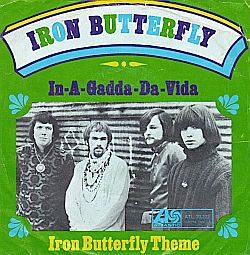
Record sleeve for single version of Iron Butterfly’s “In-A-Gadda-Da-Vida.” Click for digital version.
Music Player
“In-A-Gadda-Da-Vida” – Iron Butterfly
(shortened version)
The song — sampled above in its radio-shortened version — uses some repeating lyrics built around the song’s title line. That title was derived, by some counts, from “in the garden of Eden.” The track was written by vocalist, organist, and bandleader, Doug Ingle.
Legend has it that Ingle wrote the song when he was in his cups, or worse, spending the day drinking red wine, as former band mate Ron Bushy recounted in a 2006 interview. But when Ingle was asked about the song’s title, he couldn’t pronounce it correctly, so Bushy wrote it down as he heard it, phonetically. “In-A-Gadda-Da-Vida” was the translation, and the name stuck. As for the music, in its day, the song hit the mark – especially in extended play. And that was important in the event its listeners were in an “altered state,” as some might have called it back then, also known as “stoned.” In such condition, devotees of the band could listen to “In-A-Gadda-Da-Vida” for hours. But that was 1968.
Called a one-hit wonder by some, and worse by others, “In-A-Gadda-Da-Vida” is a tune that can’t be dismissed or laughed off, however. For in its day, this song and its album by the same name, sold millions and millions of copies. The album was released by Iron Butterfly in mid-June 1968, with the song “In-A-Gadda-Da-Vida” comprising the entire first side of the vinyl edition. It sold more than 4 million copies right out of the gate – and millions more later that year.“In-A-Gadda-Da-Vida” is no joke; it has been ranked among the world’s best-selling albums, and by Iron Butterfly’s count, has sold more than 30 million copies. According to some listings, the album version of In-A-Gadda -Da-Vida, is ranked among best-selling albums worldwide. Iron Butterfly’s website reports the album has sold more than 30 million copies worldwide, although others dispute this claim. In July 1968, a shortened version of the song, adapted for radio play, was released by ATCO in a 2:53 minute format. The single also climbed into the Top 30. The album stayed on the Billboard albums chart for 140 weeks, 81 of them in the Top 10. Part of Iron Butterfly’s initial national exposure was attributed to being an opening act for The Doors and Jefferson Airplane, two major and more popular groups of that era. Iron Butterfly’s album, meanwhile, broke sales records and far exceeded the music industry’s then “gold album” standard, selling eight million copies in its first year. In fact, In-A-Gadda-Da-Vida received the industry’s first “platinum album” award for exceeding one million in sales. The award was created and presented by then-president of ATCO Records, Ahmet Ertegun, a famous record executive who helped advance the careers of many artists.
The Fidelity Ad
“In-A-Gadda-Da-Vida” left enough of a psychic imprint on the boomer generation that Fidelity Investments found it worthy of use as a musical hook in one of its 2006 retirement planning TV ads. The song would be one of several in the Fidelity pantheon of rock-driven commercials the firm would use around that time to pitch its financial products to baby boomers. Known by some as the “Flower Power” ad, the Fidelity commercial uses an animated scene of 1960s-style psychedelic flowers and butterflies as a brief, 30-second selection from the song plays.
As the flowers grow in the scene and the music plays, Fidelity begins its pitch in print with a question: “Is your IRA blooming?” The ad then continues to another scene with more flowers branching out. “It can help to plant the right fund,” appears next on the screen. The music continues. “Consider the Fidelity Strategic Income Fund,” says the next scene, followed by a frame which shows that fund as a plant branching out with various numeric rates of income yield. Then comes the narrator with the final punchline: “Need a little flower power?” His answer: “Our retirement specialists can help. Call 1-800-Fidelity. Smart move.” As the animation continues, the words “No Loads. No IRA Fees” appear in a hedgerow. Then on the final screen, “Fidelity Investments, Smart Move” appears amid the flowers as the ad ends.
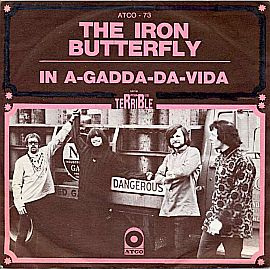
1968 French record sleeve for Iron Butterfly’s “In-A-Gadda-Da-Vida,” single.
In-a-gadda-da-vida, honey
Don’t you know that I love you?
In-a-gadda-da-vida, baby
Don’t you know that I’ll always be true?
In September 2005, Fidelity had begun using rock music to reach boomers, beginning with former Beatle Paul McCartney, who launched the Fidelity ad series using some Wings music on ABC-TV’s widely-watched Monday Night Football program. In March and April 2006, as Fidelity continued to air its campaign, Fidelity spokeswoman Jenny Engle explained that her company chose “In-A-Gadda-Da-Vida” for use in the campaign specifically to target boomers, calling the song “a classic anthem for a lot of people” in that age group. “The key is to catch people’s attention,” Engle said at the time. The spot was created by Arnold Worldwide in Boston, MA. The Fidelity “Flower Power” TV ad also appeared during the February 2007 Grammy Awards show.
Boomer Bucks?
After the ad’s initial run in 2006, San Diego Union Tribune reporter Michael Stetz tracked down some of the band’s founders, by then in their mid-60s. “I guess the method to their madness,” said former Iron Butterfly drummer Ron Bushy, …Fidelity must have thought that “all the baby boomers who got stoned listening to that song are now all grown up and have money.” referring to Fidelity’s use of the music, “is that all the baby boomers who got stoned listening to that song are now all grown up and have money.” Bushy, 64, was then living in the Los Angeles area. Bushy’s investments, however, were not with Fidelity. Bushy and Lee Dorman, another band member, didn’t know that “In-A-Gadda-Da-Vida” was going to be used to sell mutual funds and IRAs until they saw the ad on TV. Meanwhile, Iron Butterfly the band – although in somewhat different form as of 2006 – was still touring occasionally, and Bushy and Dorman figured the ad could only spread their music around to their benefit. More royalties would come in for band members, and as Bushy pondered the possibilities: “Maybe we’ll get a lot more gigs,” he offered. No word on how many new accounts came to Fidelity as a result of its boomer campaign.
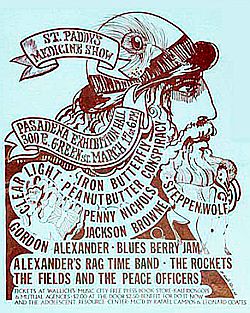
Poster for March 1968 “St. Paddy's Medicine Show,” Pasadena Exhibition Hall, featuring Iron Butterfly, Peanut Butter Conspiracy, Steppenwolf, Jackson Browne & others.
Other stories at this website on the use of popular music in advertising include, for example, “Madonna’s Pepsi Ad,” “Nike & The Beatles,” “Sting & Jaguar,” “Selling Janis Joplin,” and, “Big Chill Marketing.”
Thanks for visiting — and if you like what you find here, please make a donation to help support the research and writing at this website. Thank you. – Jack Doyle
|
Please Support Thank You |
____________________________________
Date Posted: 29 June 2011
Last Update: 22 February 2019
Comments to: jdoyle@pophistorydig.com
Article Citation:
Jack Doyle, “Iron Butterfly, 1968-2006,”
PopHistoryDig.com, June 29, 2011.
____________________________________
Sources, Links & Additional Information
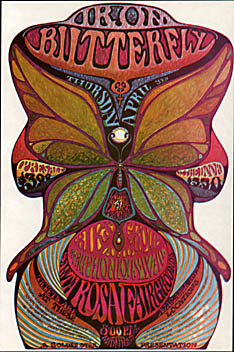 A late 1960s-early 1970s poster, psychedelic style, announcing Iron Butterfly appearance at the Santa Rosa, CA Fairgrounds. |
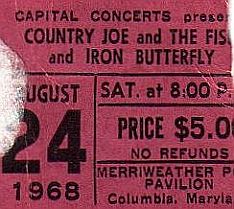 Ticket stub from Aug 24, 1968 concert at Merriweather Post Pavilion, in Maryland. |
“Iron Butterfly,” in Holly George-Warren and Patricia Romanowski (eds), The Rolling Stone Encyclopedia of Rock & Roll, Rolling Stone Press, New York, 3rd Edition, 2001, pp.465-466.
Michael Stetz, “Iron Butterfly’s in An IRA Ad? Bummer,” San Diego Union-Tribune, April 2, 2006.
“Iron Butterfly,” FavoriteMusicians.com, 2008.
Steve Huey, “Iron Butterfly – Biography,”All Music Review.
“In-A-Gadda-Da-Vida”(song), Wikipedia.org.
Brian Steinberg and Ethan Smith, “Advertisers Are Hunting for Fresh Pop Hits,” Wall Street Journal, Friday, June 9, 2006.
Iron Butterfly Website.
“Animated Flowers,”Fidelity TV ad, YouTube.com.
“List of Best-Selling Albums Worldwide,” Wiki- pedia.org.
A Mad Peck Studios Poster announcing an Iron Butterfly appearance in June 1970 in the Providence, Rhode Island area.
Michael Paoletta, Making The Brand: “Flower Power,” Billboard, April 15, 2006, p. 21.
Mark Caro, “In-a-Gadda-Da-Grammys,” Chicago Tribune .com, Feburary 11, 2007.
“Music on ESPN NFL Broadcasts,” ESPN.com, September 11, 2011.
_____________________________

